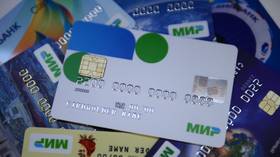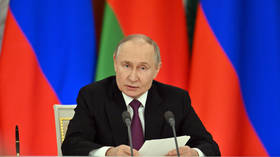Russia and Iran connect national payment networks – media

Moscow and Tehran have officially finalized the pairing of their national payment systems, which will allow travelers from the two countries to use their domestic debit cards for purchases in either Iran or Russia, media in Iran are reporting.
Addressing a formal ceremony in Tehran on Monday, Central Bank of Iran (CBI) Governor Mohammad-Reza Farzin described the connection of Russia’s Mir and Iran’s Shetab payment systems as a major step towards economic cooperation and de-dollarization, as well as facilitating economic and tourism relations between the two countries.
“The project … started with the aim of creating integration in the payment networks and facilitating financial transactions between the citizens of the two countries,” the CBI chief stated, as quoted by the Tehran Times, noting also that the process will consist of three phases.
According to Farzin, the first phase provides for the possible use by Iranian nationals of their banking cards in Russian ATMs. “In this way, now Iranian tourists can easily receive ruble notes from Russian ATMs using the riyal balance of their Shetab cards,” he explained.
In the second phase, Russian citizens will be able to withdraw cash in Iran using their domestic bank cards. In the third phase, Iranian Shetab cards will become acceptable at point-of-sale (POS) terminals installed in Russian stores.
Farzin had earlier told reporters that the agreement to connect the two countries’ domestic payment systems was finalized during a meeting with his Russian counterpart Elvira Nabiullina on the sidelines of the Financial Congress of the Bank of Russia in St. Petersburg in July.
It was indicated earlier that Tehran could eventually start using Mir for settlements with other international partners.
Moscow and Tehran have strengthened relations in the face of Western sanctions, boosting trade and financial cooperation.
Russia started developing its own national payment system when the US and its allies targeted the country with Ukraine-related sanctions in 2014. Mir cards entered circulation in December 2015.
In 2022, when Moscow was hit by further sanctions over the escalation of the Ukraine conflict and many Russian banks were cut off from SWIFT, Visa and MasterCard, the government started promoting the domestic system as a reliable alternative.
Mir cards are accepted in a number of countries, including Abkhazia, South Ossetia, and Belarus, and with certain limits in Armenia, Kazakhstan, Kyrgyzstan, Tajikistan, Cuba, Venezuela, and Vietnam. The US sanctions had forced some banks in Armenia, Kyrgyzstan and Kazakhstan to halt transactions and stop accepting Mir cards. Meanwhile, another 15 countries have reportedly expressed an interest in accepting Mir cards on their territory.














